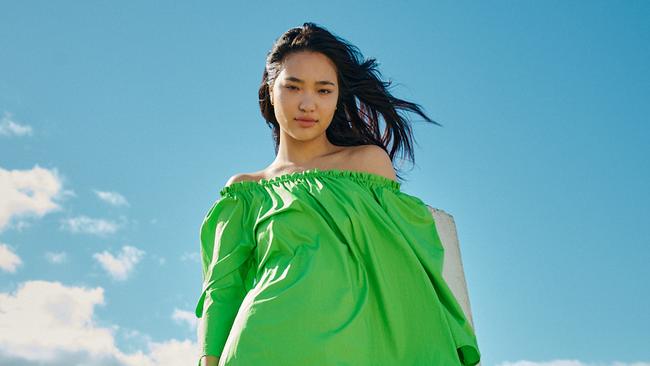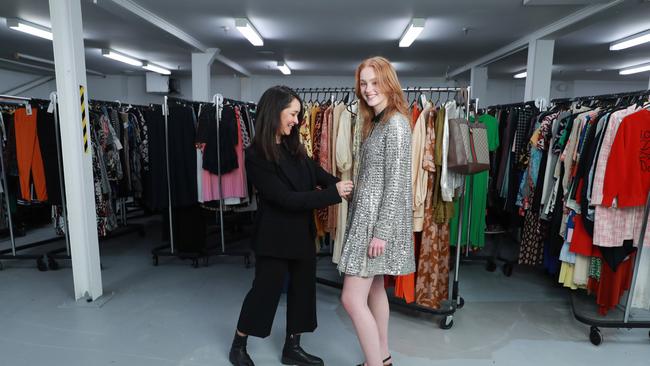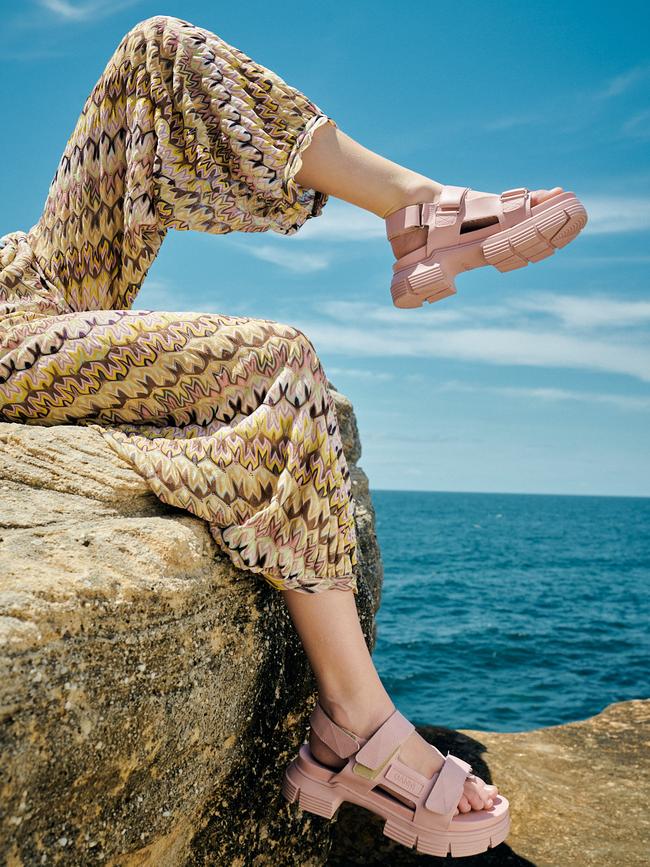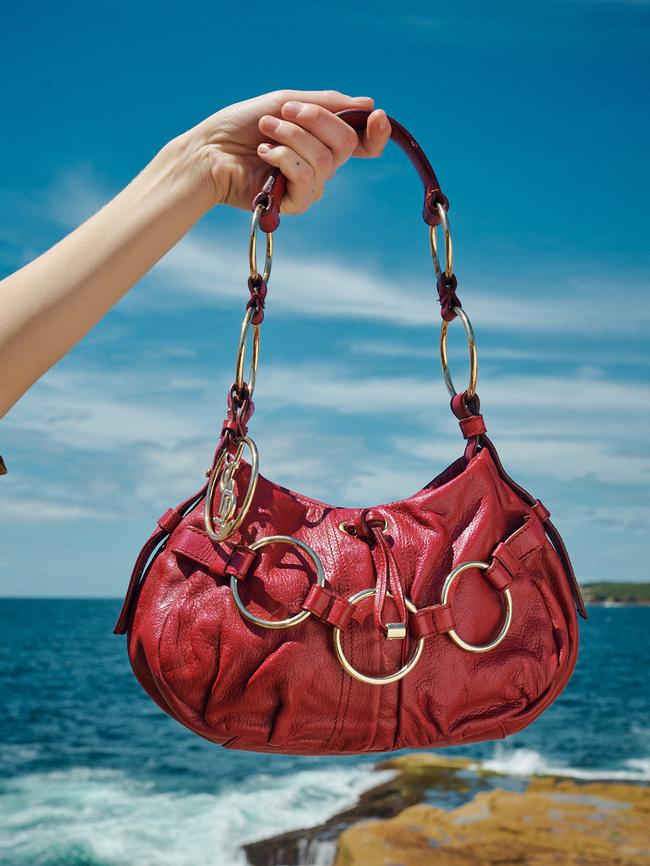Technology makes buying and selling preloved clothes easier
As fashion resale explodes online, second-hand shopping is no longer about rummaging in the charity bin.

There’s no question – thrift is becoming big business. This month the world’s biggest online thrift store thredUP posted a quarterly revenue result of $US76.4m (about $108.8m). According to the US-based company, which launched in 2009 and went public in August 2021, that’s year-on-year growth of 27 per cent.
It reflects one of the biggest cultural shifts to transform the global fashion industry in recent years: the fashion resale market is no longer a niche, as a growing number of people are choosing to purchase preloved clothing instead of new.
“Second-hand no longer means hand-me-down,” Australian retail veteran Alex Dimou says. “The conversation surrounding what second-hand means has become more educational as the idea of conscious consumption becomes more mainstream.”
As the founder of Sydney vintage clothing institution Uturn, which specialises in retro sportswear and vintage denim, Dimou has watched interest in second-hand fashion swell since launching his first store 20 years ago. That trend has only accelerated in the past five years.
One factor that is driving purchases of second-hand fashion is the growing recognition of the devastating impact that some elements of fashion manufacturing have on the planet. According to the UN, the global fashion industry produces 20 per cent of the world’s water waste and up to 8 per cent of its carbon emissions.
Burgeoning tech – including social media – has also played a role. Online resale platforms such as Vestiaire Collective and Depop have streamlined the process, making it easier to buy and sell preloved clothes. For example, Depop and Vestiaire users can photograph and list their own items for sale, and all transactions are made through the app, removing the need for a bricks-and-mortar store to be involved.
Then there’s the cost of living piling pressure on consumers. “Affordability is another reason our customers have embraced second-hand and vintage clothing,” Dimou says. As a general rule, an item of preloved clothing will cost less than its brand new counterpart.
But second-hand fashion is still fashion, so naturally there’s a more idiosyncratic reason to get involved. While vintage enthusiasts have been trawling the second-hand market for unique, high-end pieces for years, the internet has made the previously niche world of luxury designer resale more accessible to the masses. This has ignited an interest in archival pieces by significant designers with collectable oeuvres, such as Alexander McQueen, Raf Simons and Issey Miyake, especially among a young cohort of fashion fans.
As Dimou observes, this has led to second-hand shedding its charity bin connotations.
“More customers are turning to the preloved market for premium and designer pieces,” he says. “I’ve seen a lot of people purchase their first preloved item and be surprised by its high quality.”
Evolving from eBay
Like most of the biggest disruptions to hit the fashion industry, the online luxury resale movement was born overseas. Its biggest players, which adapted the eBay-style retail model to suit the needs of a more elevated, fashion-specific consumer, continue to be based in the global fashion capitals. The RealReal, one of the world’s biggest online luxury resale sites, is located in New York while Vestiaire Collective operates out of Paris.
While Australians can purchase from these platforms, there are the usual headaches associated with buying premium fashion from an online store based overseas – high shipping costs, surprise import duties and seasonal offerings that aren’t appropriate for the southern hemisphere.
But until recently, there wasn’t really a local alternative. While Australia is home to excellent vintage and consignment stores, their inventories tend to be highly selective, making it more difficult for the less educated shopper to engage. However, as the resale market continues to grow – market research by Business of Fashion predicts that, in the US alone, the second-hand fashion market will grow 20 per cent by 2025 to reach $US67bn – more Australians are getting involved. And more of us are opting to make our first luxury purchases secondhand.
According to a report by Australian e-commerce platform Reluv, 72 per cent of Australians bought at least one item of second-hand clothing in 2021. And figures from Gumtree reported in The Australian last week show the category of clothing, shoes and accessories accounts for more than half the items sold on the platform, which experienced a 29 per cent leap in the value of items sold in the past year.
The case for an online luxury resale platform that’s tailored to an Australian audience, in terms of the service it provides and the inventory it offers, has been mounting.
Local player
Aiming to cater for Australia’s growing luxury resale customer, late last year Dimou and his team launched a high-end companion to their first vintage business, naming it The Turn.
“The Turn was born to provide a local marketplace for premium Australian brands, recognisable international brands and contemporary fashion,” Dimou tells The Australian.
The Turn is the first local pure-play platform to trade in luxury resale at this scale – there are more than 700 brands in its inventory, 100 of which are Australian labels.
Shopping on The Turn is similar to shopping on any elevated e-commerce platform – customers can click to purchase a tiered chiffon dress from Zimmermann’s resort swim 2022 collection, for example, and have it shipped to them express.

Pieces by the world’s most in-demand luxury brands also feature among The Turn’s curated offering. At the time of writing, an embellished silver coat by Miu Miu – the buzzy Italian brand responsible for this year’s controversial resurgence of the micro mini skirt – is for sale on the site. The Turn’s sourcing team say the coat was made in 2007. For $1485, it’s yours.
Elsewhere on The Turn, a brown leather “frame” bag by minimalist brand Jil Sander, which retails for about $3760 new, is selling for $1290, while a pair of patent slingback loafers in perfect condition by cult Danish label Ganni is selling for $390 – half their original RRP.
At $210, a classic navy double-breasted blazer by Australian brand Camilla and Marc is another elegant yet sensible investment
A seller’s market
For Australians who don’t know what to do with designer pieces they no longer wear – dumping them at the op shop can seem a shame, getting a stall at a weekend market requires significant forward planning, and Facebook buy, swap and sell groups can be confusing to navigate – it’s The Turn’s selling experience that’s proving to be the biggest game changer.
As a consignment store, The Turn lists and sells items on behalf of sellers. Anyone can sign up to consign with The Turn via its website. When you do, you receive a consignment kit that includes instructions on how to get involved, and a prepaid postage bag for shipping items to The Turn’s Sydney warehouse.
From there, an in-house team receives, authenticates, measures, photographs, prices and lists the items for sale online. When an item sells, the seller takes home 80 per cent of the sale price. According to the company, this is the most competitive rate on the Australian market and is in line with what the most established global resale platforms offer.
Making the consigning process as seamless and low-touch as possible was integral to encouraging sellers to get involved and give their clothing a second life, says Dimou, who also heads up Australian clothing and household textile recycling company King Cotton.
“The process is simple and convenient, which is a major draw card for customers with limited time,” he notes.
Another perk for Australian sellers is the brand recognition. While The RealReal’s largely American customer, for example, is less likely to recognise a Lee Matthews smock dress, in Australia, the Sydney-based designer enjoys a cult-like following. On The Turn, preloved pieces by the brand sell fast.
“We find that a section of our customer base gravitates towards purchasing local designers, because they resonate with our unique sense of Australian style,” Dimou says.
“Australians are selling pieces to customers just like them.”
For the time being, the local resale market remains nascent. But early adopters such as The Turn are making it easier than ever for customers to get involved, and there are signs that the space is set to continue growing in line with global trends.
Reluv estimates that Australia’s resale market is “potentially worth just over $568m”. Resale, it concludes, is no longer a small and insignificant component of the local fashion sector.
If you have a Gucci blouse or Colette Dinnigan pant suit sitting unworn in your wardrobe, now might be the perfect time to pop it in a prepaid post bag and give it a second life. Likewise, if you’re thinking about making your first luxury purchase, don’t discount a second-hand investment.
History shows it’s much less likely to go out of style.


-
Get the most from the market: advice for first-time buyers and sellers
If you’re selling…
Get the most from the market: advice for first-time buyers and sellers
If you are buying clothes and accessories for future resale, it’s important to take very good care of them from the moment of purchase, Dimou says.
“Regularly check for tears, rips, marks or stains and things that might need repairing,” he says.
For bags and shoes, “always keep the original packaging and stuffing to store away when you’re not using it, so the item keeps its shape”.
Finally, “always read your care labels and launder your clothing accordingly”. The better shape an item is in, the more likely it is to sell.
If you’re buying…
“If you’re new to resale or looking to invest in your first luxury purchase, it’s helpful to consider cost-per-wear,” Dimou says. “Something that is classic and can be styled in many ways will serve you for years to come.”
It’s also a great idea to research the item you’re buying. What season was it from? Was it part of a significant runway show or collection? What fabric is it made from, and how much is it selling for elsewhere?
This way, when it comes time to give your piece yet another life, you’ll have a story to tell the next generation of buyers hungry for one-of-a-kind designs.


To join the conversation, please log in. Don't have an account? Register
Join the conversation, you are commenting as Logout